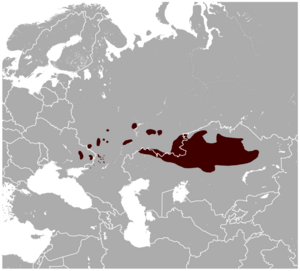Steppe marmot facts for kids
Quick facts for kids Bobak marmot |
|
|---|---|
 |
|
 |
|
| above in Ukraine, below in Volgograd Oblast, Russia | |
| Conservation status | |
| Scientific classification | |
| Genus: |
Marmota
|
| Species: |
bobak
|
 |
|
| Bobak marmot range. | |
The bobak marmot (Marmota bobak), also called the steppe marmot, is a type of marmot that lives in the grassy plains (called steppes) of Eastern Europe and Central Asia. These animals are very social and live in groups. They like open grasslands and even the edges of farm fields.
Bobak marmots sleep through more than half the year in a deep hibernation. When they have babies, a mother usually has about five young. It takes about three years for young marmots to grow up and be able to have their own babies. Young male marmots leave their family group after their second winter. About 60% of adult female marmots have babies each year.
Contents
What are Bobak Marmots?
Bobak marmots are often described as being like a bigger version of the North American prairie dog. They have a round body, short legs, and a short tail. Their fur is sometimes used to make hats and coats.
Where Do Bobak Marmots Live?
Bobak marmots are originally from the steppes of Eastern Europe and Central Asia. You can find them from central and eastern Ukraine, through southwestern Russia, and into northern and central Kazakhstan.
Long ago, they lived in one big area, but now their homes are spread out. They used to live in southeastern Belarus and eastern Hungary but are no longer there. In some places, people have brought them back, and their numbers are slowly growing again.
In the highlands of Kazakhstan, bobak marmots sometimes live near another type of marmot called the gray marmot. When they live close, their features can be a mix of both types. In 2019, scientists used satellite pictures to find about 7,000 bobak marmot burrows in Kazakhstan. These burrows are home to around six million marmots!
Bobak Marmot Life Cycle
Bobak marmots are active for about five and a half months each year. Young marmots leave their family group after their second hibernation. A mother marmot usually has a little over five babies at a time. It takes at least three years for them to become adults and be able to have their own young. About 60% of adult female marmots have babies in any given year.
When they sense danger, bobak marmots make a single alarm call. Studies show that marmots living on steep hills call faster than those living on flat land.
Health of Bobak Marmots
Like other marmots, bobaks can get sick with a serious illness called bubonic plague. Scientists believe that a group of bobak marmots in the Ural Mountains might have carried the bubonic plague that caused a big sickness in western Russia in the late 1800s.
Snow leopards sometimes hunt marmots. Marmots can also help protect other animals that snow leopards hunt by being an easier target.
See also


